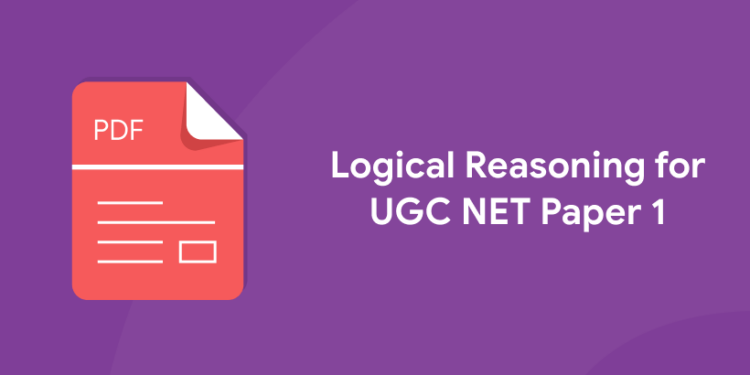Table of Contents
UGC NET Exam is the exam that examines the eligibility of Indian Nationals for ‘Assistant Professor’ or for ‘Junior Research Fellowship and Assistant Professor’ both in Indian Universities and Colleges. It includes types of reasoning UGC NET questions in Paper 1.
Understanding the structure of arguments UGC NET is a crucial part of the UGC NET Paper 1 Syllabus 2020-21 for Logical Reasoning. With proper preparation and Logical Reasoning Notes for UGC NET, you can effortlessly attempt all the questions in the Paper-I exam perfectly.
Download the Entri Learning App Now and Prepare Well!
Logical Reasoning Syllabus for 2022 UGC NET Paper 1
Understanding the structure of arguments UGC NET is an essential part of the UGC NET Paper 1 Syllabus for Logical Reasoning. Here is the main topics in the syllabus of Logical Reasoning for UGC NET 2022.
- Comprehending the structure of arguments. Assessing and determining deductive and inductive reasoning.
- Analogies.
- Venn diagram: Simple and multiple usages for establishing the validity of arguments.
- Indian Logic: Means of knowledge.
Pramanas: Pratyaksha (Perception), Anumana (Inference),
Upamana(Comparison), Shabda (Verbal testimony),
Arthapatti (Implication)
Anupalabddhi (Non-apprehension). Structure and types of Anumana (inference), Vyapti (invariable relation), Hetvabhasas (fallacies of inference).
Logical Reasoning Notes 2022
Argument
An argument is a sequence of statements, named the premises, intended to define the degree of truth of another statement, the conclusion.
Types of Arguments
There are normally three kinds of arguments as follows:
- Deductive Argument/Deductive Reasoning
- Inductive Argument/ Inductive Reasoning
- Abductive (or Hypothetico-Deductive) Argument/ Abductive Reasoning
-
Deductive Argument:
The deductive argument forms with a general statement and analyses the opportunities to reach a specific, logical conclusion.
It is considered from general to particular.
-
Inductive Argument:
It directs to an argument that takes precise information and makes an
the all-around generalization that is supposed probable, entitling for the fact
that the conclusion may not be correct.
-
Abductive
(or Hypothetico-Deductive) Argument:
The abductive argument is to assume a logical assumption, inference,
conclusion, hypothesis, or best guess from observation or set of observations.
Analogy
‘Analogy’ points that ‘correspondence’ or ‘Similar items. An analogy is a kind of reasoning in which a comparison is created between things that have similar features. In other words, we can say the similarity or similar relation present between the provided subject. In the analogy-based question section, you will see that a particular relationship is given and another similar relationship has to determine from the alternatives given.
Analogy-based tests are indicated to test a candidate’s overall knowledge, power of verbal reasoning, and capability to think concisely and accurately.
There are three types of Analogy are presented-
- Number Analogy
- Letter Analogy
- Word Analogy
Click Here to Download Notes on UGC NET General Paper 1 PDF
Venn Diagram
A Venn diagram directs to a representative of the relationships between and among sets or groups of objects that convey something in common.
- The major objective of this section is to test your proficiency in the relation between some words of a group by diagrams.
- In this kind of question, you will be given some figures of circles and some in words. You have to select a figure which denotes the given words to the maximum extent.
- Illustration of some conditions (relations).
Indian Logic: Means of knowledge
According to the Vedic philosophy in India, there are 6 kinds of Pramanas. They are as follows:
- Pratyaksha Pramana (Perception) – By Pratyaksha Pramana represents knowledge-based through perception. It can be direct or indirect to any person involved.
- Direct perception – It conveys through our sensory organs directly. Like nose (smell), skin (touch), eyes (see), ears (sound), tongue (taste). Here, the knowledge takes place when it is in direct connection with the sensory organs. It is also comprehended as anubhava or experience.
- Indirect perception – The knowledge occurs based upon smriti or memory. For example, we all know what an apple is looks like. This knowledge gets stored in our memory. So, whenever we see red-colored and round-shaped fruit, we can smoothly associate it with an apple. Our memory directly organizes it.
- Anumana Pramana (Assumption) – Here the knowledge is acquired not through any sense organs but anumana or assumption. We assume things from what we don’t see but from what we see. For example, we can assume physical or emotional pain when we see someone crying or we can connect fire with the smell of smoke.
- Upamana Pramana (Comparison) – It is a kind of knowledge we attain by the assumption of similarity between the two distinct types of knowledge. It is based on comparison and not just only perception or assumptions.
- Arthapatti Pramana (Assumption or Implication) – By Arthapatti Pramana, we comprehend the knowledge which we obtain through the relation and its implications. It contains supposition, belief, and presumption. We obtain this type of knowledge either what we have seen or heard and by pure assumption.
- Anupalabdhi Pramana (Apprehension and Non- Apprehension) – It is based on the suspicion of a non-existent thing which is based on nonperception. For example, if there is no one in the room, as we cannot see anyone in the room at that moment, we deduce that there is no one in the room.
- Shabda Pramana (Word or Verbal Statement) – This is especially through verbal expression. We obtain a lot of knowledge through verbal statements, symbols, texts, or words. We either say this or write it. A verbal statement must have a proper cause for its information to be true. Earlier in Indian philosophy Vedas were believed to be the most trustworthy source of knowledge. But western philosophers dumped this idea and named it context-based knowledge. In modern times, we depend on books, newspapers, TV news, etc. to construct our opinion.
Tips and Tricks for Study
- Make notes of frequently asked questions of Logical Reasoning.
- Memorize the shortcut ways to solve reasoning and aptitude questions.
- Aim for speed and accuracy along with knowledge.
- Practice online mock tests for better study.
The study notes furnished here have connected all the topics and explained them more easily. Along with these notes, it is good to have explored the UGC NET Logical Reasoning Books and Logical Reasoning questions and answers for UGC NET that cover all the topics. Make sure you have the right book for practice that will help you to get good marks.
Apart from all these tips, it is very crucial to be confident and stay positive. Without that nothing can be accomplished. Stay clear and attain your goals.
Students training for the UGC NET Paper 1 comprehend that Logical Reasoning is one of the most significant sections of the paper 1 syllabus. The primary objective of UGC NET EXAM PAPER is to access the teaching and research quality of the candidates. Through this article, the Entri Learning App is desired at collecting all required details and UGC NET Paper 1 Notes for better study.
Download the Entri Learning App for Pieces of Information Regarding UGC NET!













